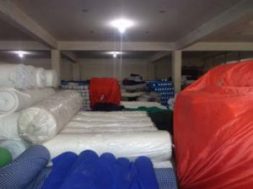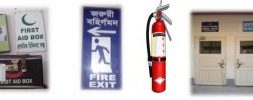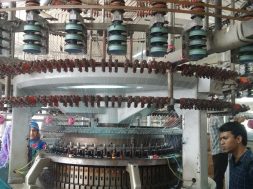A Typical Knit Composite Garments Factory Inventory Management System
A Typical Knit Composite Garments Factory Inventory Management System
Grey fabrics store:
All the grey fabrics are stored in the fabric store, near the batch section. Different types of fabrics arc listed in the sheet according to the fabric types, quantity & consumer’s requirements. Fabrics GSM, shrinkage, diameter & other properties are also taken into consideration. The batches are prepared by taking the required fabrics from the grey store. Fabrics are stored in 3 sections: –
- Cut panel area.
- Fabric inventory area.
- Accessories section area.
1 . Cut Panel Area:
In cut panel area 2 types of storing is done.
⇒ One for the fabric or cut part stored both front & back part with solid dye or no printing or cut part
⇒ Other types are for the cut part of the fabric whose front side needed to print.
For printing cut parts 1st both cut parts are received from cutting section.
- Then the front part is sent for printing to the printing section.
- Then after finishing of printing the printed part again sent to cut panel area.
- Then assembling of front part & back part of the garment get done.
⇒ In cut panel area 2 types of tools are used for storing cut parts.
- Some cut parts are kept on rack which Is used for late sewing process.
- Some are kept on trolley which is used for instant sewing.
The main task of fabric storage section is to receive cut panel to delivery into sewing section. Here safety stock is 60000 kg. Line wise cutting part should be kept.
2 . Fabric Inventory Area:
-
- Rack is used for fabric storing according to name of buyer mentioned on rack.
- No electricity is used on storing section to avoid from fire accident this system get mentioned.
- Bin card is used for tracking
- In this storage area buyer order, color, size wise regularity is maintained & registered.
- In fabric order sheet according to buyer requirement fabric is ordered to come in fabric store at the right time.
- Then after the delivery of fabric to fabric store area it gets matched with order sheet whether it is ok or not with the buyer requirement.
- After that when fabric is sent to buyer challan is used to keep track of how much fabric is needed to deliver & how much fabric has been delivered.
- According to style no, order sheet & delivery challan can be found for each delivery.
- A safety stock of this storage section is 80 tons.
In fabric inventory area, different types of fabric were stored. Like for Knit Fabric.
| Pique/Lactose | Polyester viscose. |
| 100% cotton | Single jersey. |
| Rib | Fleece |
| Polyester | Terry ETC. |
Accessories Section Area:
| Care label | Hang tag |
| Size label. | Plastic zipper |
| Snap button | Brand label (Austin, Heisenberg etc.) |
| 4H button | Elastic |
| Tag pin | ETC. |

Dyes & Chemicals Store:
In this storage section different types of accessories get stored according to buyer requirements:
There is a different time for dyes & chemicals Various types of dyes & chemicals are stored here according to the dyes & chemical company. Different types of dyes & chemicals are listed in a sheet. In the sheet the stored quantity of dyes & chemicals are also included. Every day the sheet is updated & a copy of this sheet is supplied to the AGM (production), Dye house & lab section.
Finished Goods:
Finished dyed fabrics are supplied to its garments cutting section. So dyed finished fabrics are stored for short time in the finishing section. All the delivered fabrics are noted on the tally khata according to the lot no, quantity, fabrics diameter, buyers name, color & considering other technical parameters.

Spares:
Required amount of spares of different machines are stored in the mechanical store room. All the spares are listed in a sheet which is controlled by the mechanical & maintenance personnel. Spares are arranged in the store room according to their size, quantity & requirements. There are shelves in the store room to keep the small spare parts.
Some Papers of Inventory:
- Commercial invoice : for custom very short packing list
- Detail packing list: more detail packing list
- Actual packing list : detail and more accurate packing list
Stock Condition Assessment:
- Any item found damaged or deteriorated is segregated and disposed off accordingly.
- Concerned departmental heads are consulted to asses if the goods can be used or not
- List of obsolete /unusable items is prepared and submitted to the director for disposable
(59)


